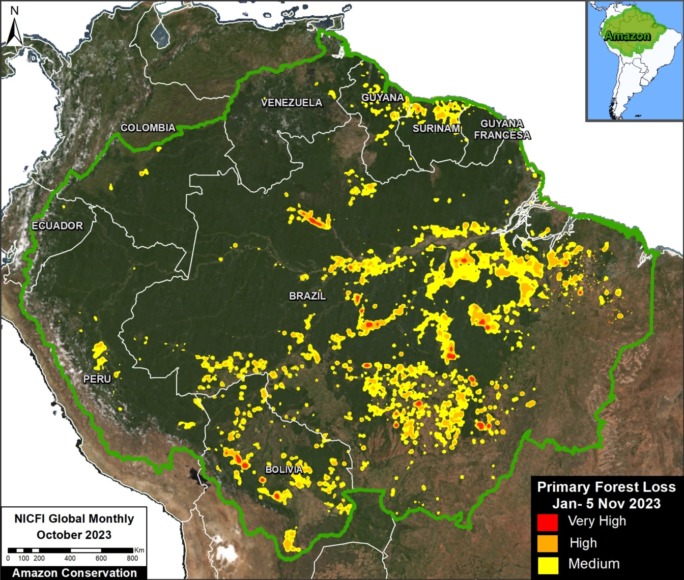MAAP #201: Amazon Deforestation & Carbon Update for 2023

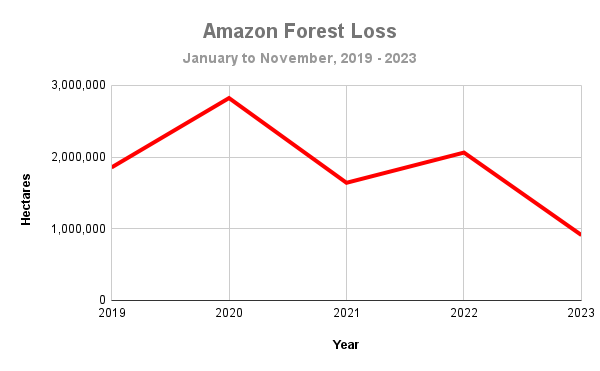
Graph 1. Major decrease in primary forest loss in 2023 compared to both last year 2022 and the recent peak year 2020, across the entire Amazon biome. Data: ESA/S2, GFW, ACA/MAAP.
As national policymakers begin the global COP28 climate summit in Dubai, we provide here a concise update on the current state of Amazon forest loss and remaining carbon reserves, both based on the latest cutting-edge data.
For Amazon forest loss, we analyze the primary forest loss alerts known as GLAD-S2, which are based on 10-meter resolution optical imagery from the European Space Agency’s Sentinel-2 satellite1. These advanced alerts have been available from 2019 to present.
For Amazon carbon reserves, we analyze the newly updated version of NASA’s GEDI data2, which used lasers aboard the International Space Station to provide recent estimates of aboveground biomass density on a global scale. This data has a 1-kilometer resolution and covers the time period of April 2019 – March 2023.
In summary, we report two key findings:
- A dramatic reduction (over one-half) in primary forest loss between the current year 2023 and last year 2022 across the Amazon. The biggest declines were documented in the Brazilian and Colombian Amazon (59% and 67%, respectively).
j - Over 78 billion metric tons of aboveground biomass across the Amazon biome, which converts to over 37 billion metric tons of carbon. The highest carbon densities are located in the northeast (Suriname, French Guiana, and northeast Brazil) and southwest (southern Peru) sections of the Amazon.
Amazon Forest Loss
We estimate that forest loss dropped by 55.8% between 2023 (911,740 hectares) and 2022 (2,062,939 hectares). The loss is even more striking (dropping by over two-thirds, 67.7%) when compared to 2020 (2,823,475 hectares). It is important to emphasize that these are all directly relevant comparisons, covering the same time frame of January to early November for each year.
Graph 1 (see above) illustrates this major decrease in primary forest loss in 2023 compared to both last year 2022 and the recent peak year 2020, across the entire Amazon biome.
Graphs 2 and 3 (see below) break down these results for the Brazilian Amazon and western Amazon (Bolivia, Peru, and Colombia), respectively. Note the especially large forest loss declines in Brazil (59%) and Colombia (67%). We did document an increase in primary forest loss in three countries of the northeast Amazon (Suriname, Guyana, and Venezuela) during 2023, but this seems to be mostly due to natural causes.
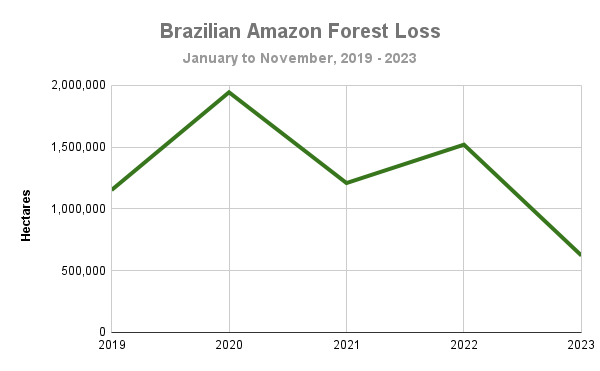
Graph 2. Major decrease in primary forest loss in 2023 compared to both last year 2022 and the recent peak year 2020, in the Brazilian Amazon. Data: ESA/S2, GFW, ACA/MAAP.
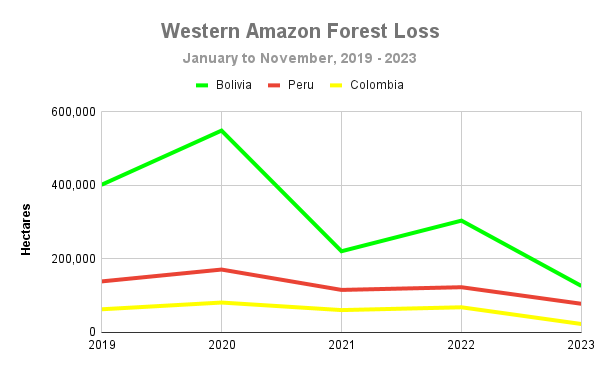
Graph 3. Major decrease in primary forest loss in 2023 compared to both last year 2022 and the recent peak year 2020, in the western Amazon (Bolivia, Peru, Colombia). Data: ESA/S2, GFW, ACA/MAAP.
Although primary forest loss is way down across the Amazon in 2023, we did document the clearing of nearly a million hectares (911,740 ha). Figure 1 shows the distribution of this loss. Note the concentrations in the following sections of the Amazon: eastern and southern Brazil, across Bolivia, central and southern Peru, northwest Colombia. Hotspots in the northeast Amazon (Suriname, Guyana, and Venezuela) are mostly due to natural causes.
Amazon Carbon Reserves
Figure 2 displays aboveground biomass across the Amazon biome. Note the highest carbon densities (indicated in bright yellow) are located in the northeast Amazon (Suriname, French Guiana, and the northeast corner of Brazil) and southwest Amazon (southern Peru). Also note that many parts of Ecuador, Colombia, Venezuela, Guyana, Bolivia, Brazil and northern Peru have high carbon densities as well.
As first reported in MAAP #199, we calculated over 78 billion metric tons of aboveground biomass across the Amazon biome (78,184,161,090 metric tons). Using a general assumption that 48% of this biomass is carbon3, we estimate over 37 billion metric tons of carbon across the Amazon (37,528,397,323 metric tons).
Note that these totals are likely underestimates given that the laser-based data has not yet achieved full coverage across the Amazon (that is, there are many areas where the lasers have not yet recorded data, leaving visible blanks in the maps above).
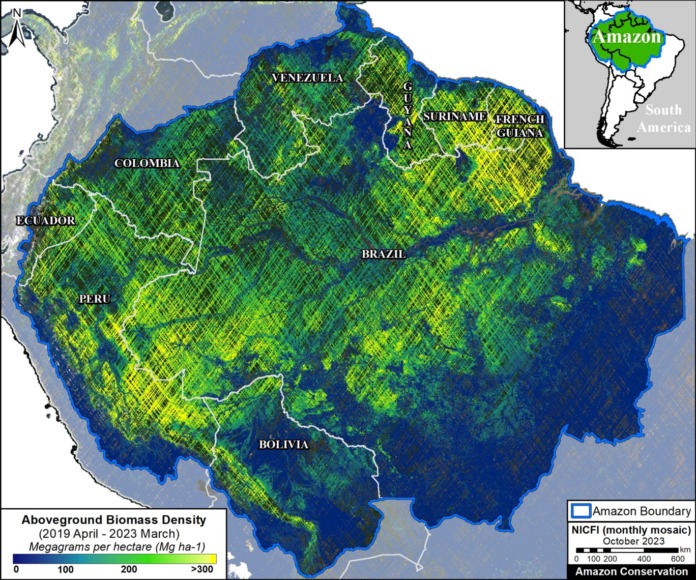
Figure 2. Aboveground biomass density (carbon estimate) across the Amazon biome, with country boundaries. Data: NASA/GEDI, NICFI.
Notes
1Information for GLAD-S2 alerts obtained from Global Forest Watch. Alerts are within a primary forest mask, where previous forest loss was removed Pickens et al 2020). These alerts are operating in the primary humid tropical forest areas of South America from January 2019 to the present. We present data covering the time frame of January 1 – November 8 for each year, so all noted annual comparisons are appropriate. Based on our analysis of final annual forest loss data for the years 2021 and 2022, we determined that using both High and Medium confidence alerts were the most accurate and conservative predictor of ultimate outcome (that is, not including Low confidence alerts).
Citation:
Pickens, A.H., Hansen, M.C., Adusei, B., and Potapov P. 2020. Sentinel-2 Forest Loss Alert. Global Land Analysis and Discovery (GLAD), University of Maryland.
2GEDI L4B Gridded Aboveground Biomass Density, Version 2.1.
https://daac.ornl.gov/cgi-bin/dsviewer.pl?ds_id=2299
3Domke et al (2022) How Much Carbon is in Tree Biomass?. USDA/Forest Service.
https://www.fs.usda.gov/research/nrs/news/highlights/how-much-carbon-tree-biomass#summary
Acknowledgements
This work was supported by NORAD (Norwegian Agency for Development Cooperation) and ICFC (International Conservation Fund of Canada).
Citation
Finer M, Ariñez A, Mamani N (2023) Amazon Deforestation & Carbon Update for 2023. MAAP: 201.
Download PDF of this article


